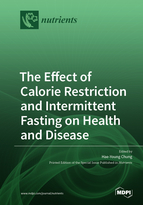The Effect of Calorie Restriction and Intermittent Fasting on Health and Disease
A special issue of Nutrients (ISSN 2072-6643). This special issue belongs to the section "Nutrition and Metabolism".
Deadline for manuscript submissions: closed (15 March 2020) | Viewed by 85695
Special Issue Editor
Special Issue Information
Dear Colleagues,
Recent biochemical studies indicate that calorie restriction (CR) is a widely accepted method for anti-aging intervention. CR and intermittent fasting (IF), which involves reduced calories but proper nutritional intake during specific periods, are interventions that can consistently promote health benefits, delay biological aging, and extend both average and maximal lifespan. Furthermore, CR can modulate age-related diseases such as Alzheimer’s disease, atherosclerosis, diabetes, obesity, cancer, and others.
Advances in omics technologies have provided a technical breakthrough that enables the investigation of DNA, RNA, proteins, and other cellular molecules and their comprehensive interactions in a biological context. Nowadays, it is possible to analyze and integrate biological processes that occur in aging systems at the molecular level using state-of-the-art techniques such as next-generation sequencing (NGS), proteomics, lipidomics, metabolomics, and epigenomics. Omics technologies and approaches analyze and provide predictive information on CR effects, molecular mechanisms, and pathways.
This Special Issue, “The effect of calorie restriction and intermittent fasting on health and disease”, focuses on the effects of calorie restriction and intermittent fasting on age-related inflammation, autophagy, metabolism, longevity, cancer, mitochondrial function, and age-related diseases.
Prof. Hae-Young Chung
Guest Editor
Manuscript Submission Information
Manuscripts should be submitted online at www.mdpi.com by registering and logging in to this website. Once you are registered, click here to go to the submission form. Manuscripts can be submitted until the deadline. All submissions that pass pre-check are peer-reviewed. Accepted papers will be published continuously in the journal (as soon as accepted) and will be listed together on the special issue website. Research articles, review articles as well as short communications are invited. For planned papers, a title and short abstract (about 100 words) can be sent to the Editorial Office for announcement on this website.
Submitted manuscripts should not have been published previously, nor be under consideration for publication elsewhere (except conference proceedings papers). All manuscripts are thoroughly refereed through a single-blind peer-review process. A guide for authors and other relevant information for submission of manuscripts is available on the Instructions for Authors page. Nutrients is an international peer-reviewed open access semimonthly journal published by MDPI.
Please visit the Instructions for Authors page before submitting a manuscript. The Article Processing Charge (APC) for publication in this open access journal is 2900 CHF (Swiss Francs). Submitted papers should be well formatted and use good English. Authors may use MDPI's English editing service prior to publication or during author revisions.
Keywords
- Calorie restriction
- Intermittent fasting
- Age-related diseases
- Metabolism
- Omics
- Mitochondria
- Autophagy
- Inflammation







